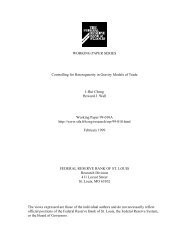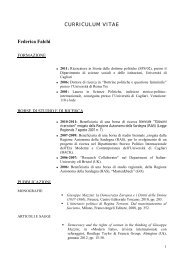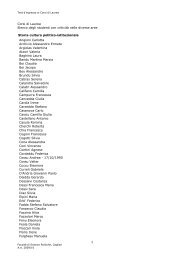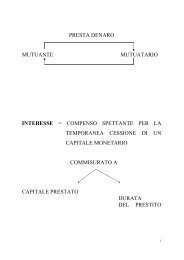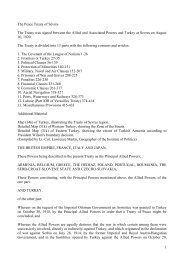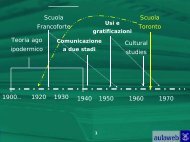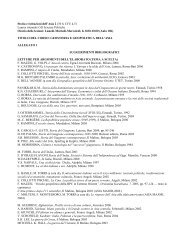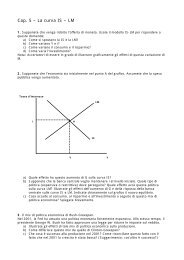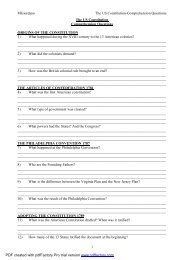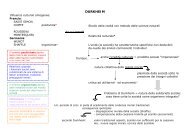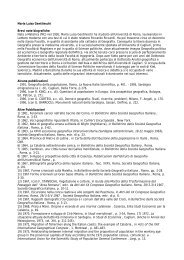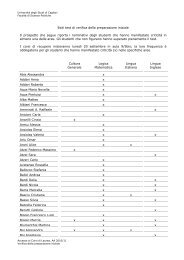MONIAC Computer
MONIAC Computer
MONIAC Computer
You also want an ePaper? Increase the reach of your titles
YUMPU automatically turns print PDFs into web optimized ePapers that Google loves.
William Phillips (economist) - Wikipedia, the free encyclopediahttp://en.wikipedia.org/wiki/A.W._PhillipsPagina 2 di 216/01/2007changed substantially over time, but remains an important feature of macroeconomic analysis of economic fluctuations.Had he lived longer, Phillips' contributions may have been worthy of a Nobel prize in economics.Phillips made several other notable contributions to economics, particularly relating to stabilization policy. This approachto economics reflects his earlier training as an engineer, something that was evident in his construction of a physicalmodel of an economy complete with pipes and water flowing around to represent the flow of transactions betweendifferent sectors.He returned to Australia in 1967 for a position at Australian National University which allowed him to devote half histime to Chinese studies. In 1969 the effects of his war deprivations and smoking caught up with him. He had a stroke,prompting an early retirement and return to Auckland, New Zealand, where he died in March, 1975.References• Mike Hally, Electronic Brains: Stories from the Dawn of the <strong>Computer</strong> Age, Joseph Henry Press, 2005, ISBN 0-309-09630-8See also• Edmund PhelpsExternal links• "When Money Flowed Like Water (http://www.inc.com/magazine/19950915/2624.html)" article from September1995 Inc. magazine, accessed April 11, 2006Retrieved from "http://en.wikipedia.org/wiki/William_Phillips_%28economist%29"Categories: 1914 births | 1975 deaths | New Zealand economists | Economists | Academics of the London School ofEconomics• This page was last modified 15:48, 4 December 2006.• All text is available under the terms of the GNU Free Documentation License.(See Copyrights for details.)Wikipedia® is a registered trademark of the Wikimedia Foundation, Inc., a USregistered501(c)(3) tax-deductible nonprofit charity.
<strong>MONIAC</strong> <strong>Computer</strong> - Wikipedia, the free encyclopediahttp://en.wikipedia.org/wiki/<strong>MONIAC</strong>_<strong>Computer</strong>Pagina 1 di 316/01/2007<strong>MONIAC</strong> <strong>Computer</strong>From Wikipedia, the free encyclopediaThe <strong>MONIAC</strong> (Monetary National Income Automatic <strong>Computer</strong>) alsoknown as the Phillips Hydraulic <strong>Computer</strong> and the Financephalograph,was created in 1949 by the New Zealander economist Bill Phillips to modelthe national economic processes of the United Kingdom, while Phillips was astudent at the London School of Economics (LSE), The <strong>MONIAC</strong> was ananalogue computer which used hydraulics to model the workings of aneconomy. The <strong>MONIAC</strong> name may have been suggested by an associationof money and ENIAC, an early electronic digital computer.Contents• 1 Description• 2 Current Locations• 3 See also• 4 References• 5 External linksDescriptionMoniac <strong>Computer</strong>The <strong>MONIAC</strong> was approximately 2 m high, 1.2 m wide and almost 1 m deep, and consisted of a series of transparentplastic tanks and pipes which were fastened to a wooden board. Each tank represented some aspect of the UK nationaleconomy and the flow of money around the economy was illustrated by coloured water. At the top of the board was alarge tank called the treasury. Water (representing money) flowed from the treasury to other tanks representing thevarious ways in which a country could spend its money. For example, there were tanks for health and education. Toincrease spending on health care a tap could be opened to drain water from the treasury to the tank which representedhealth spending. Water then ran further down the model to other tanks, representing other interactions in the economy.Water could be pumped back to the treasury from some of the tanks to represent taxation. Changes in tax rates weremodeled by increasing or decreasing pumping speeds.Savings reduce the funds available to consumers and investment income increases those funds. The <strong>MONIAC</strong> showedthis by draining water (savings) from the expenditure stream and by injecting water (investment income) into that stream.When the savings flow exceeds the investment flow, the level of water in the savings and investment tank (the surplusbalancestank) would rise to reflect the accumulated balance. When the investment flow exceeds the savings flow for anylength of time, the surplus-balances tank would run dry. Import and export were represented by water draining from themodel, and by additional water being poured into the model.The actual flow of the water was automatically controlled through a series of floats, counterweights, electrodes andcords. When the level of water reached a certain level in a tank, pumps and drains would be activated. To their surprise,Phillips and his associate Walter Newlyn found that <strong>MONIAC</strong> could be calibrated to an accuracy of ±2 %.The flow of water between the tanks was determined by economic principles and the settings for various parameters.Different economic parameters, such as tax rates and investment rates, could be entered by setting the valves whichcontrolled the flow of water about the computer. Users could experiment with different settings and note the effect on themodel. The <strong>MONIAC</strong>’s ability to model the subtle interaction of a number of variables made it a powerful tool for itstime. When a set of parameters resulted in a viable economy the model would stabilise and the results could be read fromscales. The output from the computer could also be sent to a rudimentary plotter.<strong>MONIAC</strong> had been designed to be used as a teaching aid but was discovered also to be an effective economic simulator.At the time that <strong>MONIAC</strong> was created, electronic digital computers that could run complex economic simulations wereunavailable. In 1949 the few computers in existence were restricted to government and military use. Neither did theyhave adequate visual display facilities, so were unable to illustrate the operation of complex models. Observing the<strong>MONIAC</strong> in operation made it much easier for students to understand the interrelated processes of a national economy.The range of organisations that acquired a <strong>MONIAC</strong> showed that it was used in both capacities.Phillips scrounged a variety of materials to create his prototype computer, including bits and pieces from war surplus
<strong>MONIAC</strong> <strong>Computer</strong> - Wikipedia, the free encyclopediahttp://en.wikipedia.org/wiki/<strong>MONIAC</strong>_<strong>Computer</strong>Pagina 2 di 316/01/2007such as parts from old Lancaster bombers. The first <strong>MONIAC</strong> was created in his landlady’s garage in Croydon at a costof 400 GBP.Phillips first demonstrated the <strong>MONIAC</strong> to a number of leading economists at the LSE in 1949. It was very wellreceived and Phillips was soon offered a teaching position at the LSE.Current LocationsIt is thought that twelve to fourteen machines were built. The prototype was given to Leeds University, and copies wentto three other British universities. Other computers went to Melbourne University, Harvard Business School and theRoosevelt College in the United States. The Ford Motor Company and the Central Bank of Guatemala also bought<strong>MONIAC</strong>s.A <strong>MONIAC</strong> owned by the LSE was donated to the New Zealand Institute of Economic Research in Wellington, NewZealand. This machine formed part of the New Zealand Exhibition at the Venice Biennale in 2003. The <strong>MONIAC</strong> wasset to model the New Zealand economy.A second machine from the LSE was given to the Science Museum in London and, after renovation, was placed ondisplay in the museum’s computing galleries.A working <strong>MONIAC</strong> (or Philip's Machine as it is known in the UK) can be found at the Faculty of Economics andPolitics at the Cambridge University in the United Kingdom. This machine was restored by Professor Allan McRobiefrom the Cambridge University Engineering Department.It has also been reported that the <strong>MONIAC</strong> used by the Central Bank of Guatemala is being restored for a 2005-6exhibition entitled Tropical Economies, at the Wattis Institute in San Francisco. The Wattis Institute is part of theCalifornia College of the Arts.The <strong>MONIAC</strong> at Melbourne University, Australia is on permanent display in the faculty of Commerce's Main Building.An invitation is extended to anyone interested in restoring the <strong>MONIAC</strong> to functional capacity.See also• Analogue computer• Phillips curveReferences• Mike Hally, Electronic Brains: Stories from the Dawn of the <strong>Computer</strong> Age, Joseph Henry Press, 2005, ISBN 0-309-09630-8, p. 187–205External links• BBC Radio Four programme 'Water on the brain'. (http://www.bbc.co.uk/radio4/science/electronicbrains.shtml)• NZIER's Moniac Machine (http://www.nzier.org.nz/SITE_Default/SITE_about/NZIER_Moniac.asp) Articleincludes picture of NZIER Moniac• Inc. article: When Money Flowed Like Water (http://www.inc.com/magazine/19950915/2624.html)• Wetware article: Money Flows: Bill Phillips' Financephalograph (http://wetware.hjalli.com/000066.html)• enginuity article (http://www-g.eng.cam.ac.uk/enginuity/issue12/article2.html)• RESURRECTION The Bulletin of the <strong>Computer</strong> Conservation Society Number 12 Summer 1995(http://www.cs.man.ac.uk/CCS/res/res12.htm#e)• Copy of Fortune 1952 article with both a picture and illustration of Moniac(http://www.fulltable.com/vts/f/fortune/mnc.htm)Retrieved from "http://en.wikipedia.org/wiki/<strong>MONIAC</strong>_<strong>Computer</strong>"Categories: Economics models | Early computers
<strong>MONIAC</strong> <strong>Computer</strong> - Wikipedia, the free encyclopediahttp://en.wikipedia.org/wiki/<strong>MONIAC</strong>_<strong>Computer</strong>Pagina 3 di 316/01/2007• This page was last modified 21:40, 22 November 2006.• All text is available under the terms of the GNU Free Documentation License.(See Copyrights for details.)Wikipedia® is a registered trademark of the Wikimedia Foundation, Inc., a USregistered501(c)(3) tax-deductible nonprofit charity.



